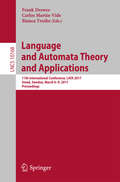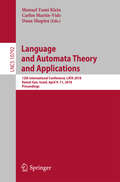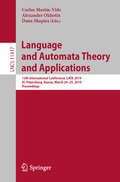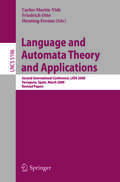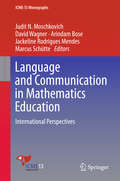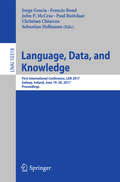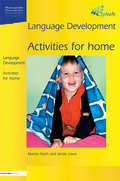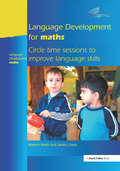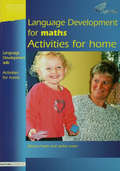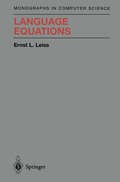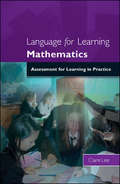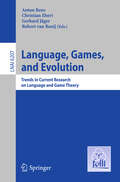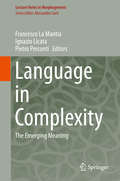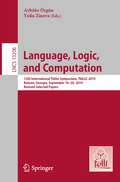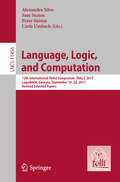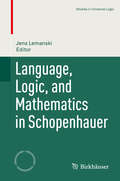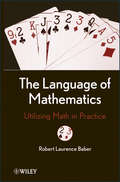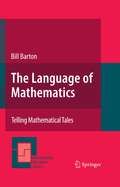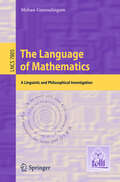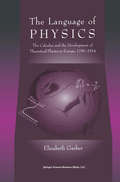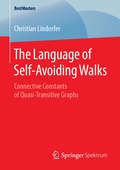- Table View
- List View
Language and Automata Theory and Applications: 11th International Conference, LATA 2017, Umeå, Sweden, March 6-9, 2017, Proceedings (Lecture Notes in Computer Science #10168)
by Frank Drewes Carlos Martín-Vide Bianca TrutheThis book constitutes the refereed proceedings of the 11th International Conference on Language and Automata Theory and Applications, LATA 2017, held in Umeå, Sweden, in March 2017. The 31 revised full papers presented together with 4 invited talks were carefully reviewed and selected from 73 submissions. The papers cover the following topics: algorithmic learning and semantics; automata and logics; combinatorics on words, compression, and pattern matching; complexity; finite automata; grammars, languages, and parsing; graphs and Petri Nets; non-classical automata; and pushdown automata and systems.
Language and Automata Theory and Applications: 12th International Conference, LATA 2018, Ramat Gan, Israel, April 9-11, 2018, Proceedings (Lecture Notes in Computer Science #10792)
by Shmuel Tomi Klein Carlos Martín-Vide Dana ShapiraThis book constitutes the refereed proceedings of the 12th International Conference on Language and Automata Theory and Applications, LATA 2018, held in Ramat Gan, Israel, in April 2018.The 20 revised full papers presented together with 3 invited papers were carefully reviewed and selected from 58 submissions. The papers cover fields like algebraic language theory, algorithms for semi-structured data mining, algorithms on automata and words, automata and logic, automata for system analysis and programme verification, automata networks, automatic structures, codes, combinatorics on words, computational complexity, concurrency and Petri nets, data and image compression, descriptional complexity, foundations of finite state technology, foundations of XML, grammars (Chomsky hierarchy, contextual, unification, categorial, etc.), grammatical inference and algorithmic learning, graphs and graph transformation, language varieties and semigroups, language-based cryptography, mathematical and logical foundations of programming methodologies, parallel and regulated rewriting, parsing, patterns, power series, string processing algorithms, symbolic dynamics, term rewriting, transducers, trees, tree languages and tree automata, and weighted automata.
Language and Automata Theory and Applications: 13th International Conference, LATA 2019, St. Petersburg, Russia, March 26-29, 2019, Proceedings (Lecture Notes in Computer Science #11417)
by Carlos Martín-Vide Alexander Okhotin Dana ShapiraThis book constitutes the refereed proceedings of the 13th International Conference on Language and Automata Theory and Applications, LATA 2019, held in St. Petersburg, Russia, in March 2019. The 31 revised full papers presented together with 5 invited talks were carefully reviewed and selected from 98 submissions. The papers cover the following topics: Automata; Complexity; Grammars; Languages; Graphs, trees and rewriting; and Words and codes.
Language and Automata Theory and Applications: Second International Conference, LATA 2008, Tarragona, Spain, March 13-19, 2008, Revised Papers (Lecture Notes in Computer Science #5196)
by Carlos Martin-Vide Friedrich Otto Henning FernauThis book constitutes the refereed proceedings of the Second International Conference on Language and Automata Theory and Applications, LATA 2008, held in Tarragona, Spain, in March 2008. The 40 revised full papers presented were carefully reviewed and selected from 134 submissions. The papers deal with the various issues related to automata theory and formal languages
Language and Communication in Mathematics Education: International Perspectives (ICME-13 Monographs)
by Judit N. Moschkovich David Wagner Arindam Bose Jackeline Rodrigues Mendes Marcus SchütteThis book considers some of the outstanding questions regarding language and communication in the teaching and learning of mathematics – an established theme in mathematics education research, which is growing in prominence. Recent research has demonstrated the wide range of theoretical and methodological resources that can contribute to this area of study, including those drawing on cross-disciplinary perspectives influenced by, among others, sociology, psychology, linguistics, and semiotics. Examining language in its broadest sense to include all modes of communication, including visual and gestural as well as spoken and written modes, it features work presented and discussed in the Language and Communication topic study group (TSG 31) at the 13th International Congress on Mathematical Education (ICME-13). A joint session with participants of the Mathematics Education in a Multilingual and Multicultural Environment topic study group (TSG 32) enhanced discussions, which are incorporated in elaborations included in this book. Discussing cross-cutting topics it appeals to readers from a wide range of disciplines, such as mathematics education and research methods in education, multilingualism, applied linguistics and beyond.
Language, Data, and Knowledge: First International Conference, LDK 2017, Galway, Ireland, June 19-20, 2017, Proceedings (Lecture Notes in Computer Science #10318)
by Jorge Gracia Francis Bond John P. McCrae Paul Buitelaar Christian Chiarcos Sebastian HellmannThis book constitutes the proceedings of the First International Conference on Language, Data and Knowledge, LDK 2017, held in Galway, Ireland, in June 2017. The 14 full papers and 19 short papers included in this volume were carefully reviewed and selected from 68 initial submissions. They deal with language data; knowledge graphs; applications in NLP; and use cases in digital humanities, social sciences, and BioNLP.
Language Development 1a: Activities for Home
by Marion Nash Jackie LoweFirst Published in 2005. Routledge is an imprint of Taylor & Francis, an informa company.
Language Development 1a: Activities for Home
by Marion Nash Jackie LoweFirst Published in 2005. Routledge is an imprint of Taylor & Francis, an informa company.
Language Development for Maths: Circle Time Sessions to Improve Communication Skills in Maths
by Marion Nash Jackie LoweBuilding on the successful 'spirals' programme this series of books addresses language development in the three core areas of the curriculum. Linking the work done in school with simple games and activities to be used at home. All activities have been tried and tested - proven effectiveness. A video CD contains explanation and demonstration of the programme and its implementation, with commetns from staff who have used it.
Language Development for Maths: Activities for Home
by Marion Nash Jackie LoweBuilding upon the successful 'spirals' programme this series of books addresses language development in three core areas of the curriculum. Linking the work done in school with the simple games and activities to be used at home. All activities have been tried and tested - proven effectiveness. the video CD with teachers' book contains explanations and demonstrations of the programme and its implementation, with comments from the staff who have used it.
Language Development for Maths: Activities for Home
by Marion Nash Jackie LoweBuilding upon the successful 'spirals' programme this series of books addresses language development in three core areas of the curriculum. Linking the work done in school with the simple games and activities to be used at home. All activities have been tried and tested - proven effectiveness. the video CD with teachers' book contains explanations and demonstrations of the programme and its implementation, with comments from the staff who have used it.
Language Development for Maths: Circle Time Sessions to Improve Communication Skills in Maths
by Marion Nash Jackie LoweBuilding on the successful 'spirals' programme this series of books addresses language development in the three core areas of the curriculum. Linking the work done in school with simple games and activities to be used at home. All activities have been tried and tested - proven effectiveness. A video CD contains explanation and demonstration of the programme and its implementation, with commetns from staff who have used it.
Language Equations (Monographs in Computer Science)
by Ernst L. LeissBeginning with an informal introduction to language equations, this book presents a framework for a general theory for solving systems of equations and relations between languages. Classical language equations, generalized derivatives, Boolean language equations, and implicit equations are presented systematically. An exploration of mixed systems and open problems rounds out the presentation.
Language for Learning Mathematics: Assessment For Learning In Practice (UK Higher Education OUP Humanities & Social Sciences Education OUP)
by Clare LeeAssessment for learning is a powerful way to raise standards and improve learning. However, as this book shows, effective assessment for learning in the mathematics classroom depends on pupils being able and willing to use mathematical language to express their ideas. When discussion, negotiation and explanation are encouraged, teachers use assessment for learning creatively, the work quickly becomes more challenging and the pupils come to see themselves as successful learners.Many pupils find it difficult to express ideas in mathematics because of problems with the language that is used to convey mathematical concepts. This book shows teachers how to help pupils express what they really know and understand, so that assessment for learning can be used. The book: Discusses what mathematical language is, and what it is notSuggests practical approaches to introducing more discourse into the classroomExplores the ideas of assessment for learning – rich questioning and dialogue, effective feedback, and peer and self assessment – and suggests how these can be used effectively in mathematics classrooms to improve learningLanguage for Learning Mathematics is key reading for teachers and trainee teachers in mathematics, as well as assessment advisors at LAs.
Language, Games, and Evolution: Trends in Current Research on Language and Game Theory (Lecture Notes in Computer Science #6207)
by Christian Ebert Gerhard Jäger Robert Van Rooij Anton BenzRecent years witnessed an increased interest in formal pragmatics and especially the establishment of game theory as a new research methodology for the study of language use. Game and Decision Theory (GDT) are natural candidates if we look for a theoretical foundation of linguistic pragmatics. Over the last decade, a firm research community has emerged with a strong interdisciplinary character, where economists, philosophers, and social scientists meet with linguists. Within this field of research, three major currents can be distinguished: one is closely related to the Gricean paradigm and aims at a precise foundation of pragmatic reasoning, the second originates in the economic literature and is concerned with the role of game theory in the context of language use, and the third aims at language evolution seen either from a biological or from a cultural perspective. Edited in collaboration with FoLLI, the Association of Logic, Language and Information, this volume is based on a selection of papers of two international conferences, one organised at ESSLLI in 2007 on language, games, and evolution, and the other organised at the ZAS in Berlin on games and decisions in pragmatics in 2008. This volume is rounded off by additional invited papers and now contains eight articles of leading researchers in the field which together provide a state-of-the-art survey of current research on language evolution and game theoretic approaches to pragmatics.
Language in Complexity: The Emerging Meaning (Lecture Notes in Morphogenesis)
by Francesco La Mantia Ignazio Licata Pietro PercontiThis contributed volume explores the achievements gained and the remaining puzzling questions by applying dynamical systems theory to the linguistic inquiry. In particular, the book is divided into three parts, each one addressing one of the following topics: 1) Facing complexity in the right way: mathematics and complexity 2) Complexity and theory of language 3) From empirical observation to formal models: investigation of specific linguistic phenomena, like enunciation, deixis, or the meaning of the metaphorical phrases The application of complexity theory to describe cognitive phenomena is a recent and very promising trend in cognitive science. At the time when dynamical approaches triggered a paradigm shift in cognitive science some decade ago, the major topic of research were the challenges imposed by classical computational approaches dealing with the explanation of cognitive phenomena like consciousness, decision making and language. The target audience primarily comprises researchers and experts in the field but the book may also be beneficial for graduate and post-graduate students who want to enter the field.
Language, Logic, and Computation: 13th International Tbilisi Symposium, TbiLLC 2019, Batumi, Georgia, September 16–20, 2019, Revised Selected Papers (Lecture Notes in Computer Science #13206)
by Aybüke Özgün Yulia ZinovaThis book constitutes the refereed proceedings of the 13th International Tbilisi Symposium on Logic, Language and Computation, TbiLLC 2019, held in Batumi, Georgia, in September 2019. The volume contains 17 full revised papers presented at the conference from 17 submissions. The scientific program consisted of tutorials, invited lectures, contributed talks, and two workshops. The symposium offered two tutorials in language and logic and aimed at students as well as researchers working in the other areas: · Language: Sign language linguistics. State of the art, by Fabian Bross (University of Stuttgart, Germany) · Logic: Axiomatic Semantics, by Graham E. Leigh (University of Gothenburg, Sweden)
Language, Logic, and Computation: 12th International Tbilisi Symposium, TbiLLC 2017, Lagodekhi, Georgia, September 18-22, 2017, Revised Selected Papers (Lecture Notes in Computer Science #11456)
by Alexandra Silva Sam Staton Peter Sutton Carla UmbachThis book constitutes the refereed proceedings of the 12th International Tbilisi Symposium on Logic, Language and Computation, TbiLLC 2017, held in Lagodekhi, Georgia, in September 2017.The volume contains 17 full revised papers presented at the conference from 22 submissions. The aim of this conference series is to bring together researchers from a wide variety of fields in Natural language syntax, Linguistic typology, Language evolution, Logics for artificial intelligence and much more.
Language, Logic, and Mathematics in Schopenhauer (Studies in Universal Logic)
by Jens LemanskiThe chapters in this timely volume aim to answer the growing interest in Arthur Schopenhauer’s logic, mathematics, and philosophy of language by comprehensively exploring his work on mathematical evidence, logic diagrams, and problems of semantics. Thus, this work addresses the lack of research on these subjects in the context of Schopenhauer’s oeuvre by exposing their links to modern research areas, such as the “proof without words” movement, analytic philosophy and diagrammatic reasoning, demonstrating its continued relevance to current discourse on logic. Beginning with Schopenhauer’s philosophy of language, the chapters examine the individual aspects of his semantics, semiotics, translation theory, language criticism, and communication theory. Additionally, Schopenhauer’s anticipation of modern contextualism is analyzed. The second section then addresses his logic, examining proof theory, metalogic, system of natural deduction, conversion theory, logical geometry, and the history of logic. Special focus is given to the role of the Euler diagrams used frequently in his lectures and their significance to broader context of his logic. In the final section, chapters discuss Schopenhauer’s philosophy of mathematics while synthesizing all topics from the previous sections, emphasizing the relationship between intuition and concept. Aimed at a variety of academics, including researchers of Schopenhauer, philosophers, historians, logicians, mathematicians, and linguists, this title serves as a unique and vital resource for those interested in expanding their knowledge of Schopenhauer’s work as it relates to modern mathematical and logical study.
The Language of Mathematics: Utilizing Math in Practice
by Robert L. BaberA new and unique way of understanding the translation of concepts and natural language into mathematical expressions Transforming a body of text into corresponding mathematical expressions and models is traditionally viewed and taught as a mathematical problem; it is also a task that most find difficult. The Language of Mathematics: Utilizing Math in Practice reveals a new way to view this process—not as a mathematical problem, but as a translation, or language, problem. By presenting the language of mathematics explicitly and systematically, this book helps readers to learn mathematics¿and improve their ability to apply mathematics more efficiently and effectively to practical problems in their own work. Using parts of speech to identify variables and functions in a mathematical model is a new approach, as is the insight that examining aspects of grammar is highly useful when formulating a corresponding mathematical model. This book identifies the basic elements of the language of mathematics, such as values, variables, and functions, while presenting the grammatical rules for combining them into expressions and other structures. The author describes and defines different notational forms for expressions, and also identifies the relationships between parts of speech and other grammatical elements in English and components of expressions in the language of mathematics. Extensive examples are used throughout that cover a wide range of real-world problems and feature diagrams and tables to facilitate understanding. The Language of Mathematics is a thought-provoking book of interest for readers who would like to learn more about the linguistic nature and aspects of mathematical notation. The book also serves as a valuable supplement for engineers, technicians, managers, and consultants who would like to improve their ability to apply mathematics effectively, systematically, and efficiently to practical problems.
The Language of Mathematics: Utilizing Math in Practice
by Robert L. BaberA new and unique way of understanding the translation of concepts and natural language into mathematical expressions Transforming a body of text into corresponding mathematical expressions and models is traditionally viewed and taught as a mathematical problem; it is also a task that most find difficult. The Language of Mathematics: Utilizing Math in Practice reveals a new way to view this process—not as a mathematical problem, but as a translation, or language, problem. By presenting the language of mathematics explicitly and systematically, this book helps readers to learn mathematics¿and improve their ability to apply mathematics more efficiently and effectively to practical problems in their own work. Using parts of speech to identify variables and functions in a mathematical model is a new approach, as is the insight that examining aspects of grammar is highly useful when formulating a corresponding mathematical model. This book identifies the basic elements of the language of mathematics, such as values, variables, and functions, while presenting the grammatical rules for combining them into expressions and other structures. The author describes and defines different notational forms for expressions, and also identifies the relationships between parts of speech and other grammatical elements in English and components of expressions in the language of mathematics. Extensive examples are used throughout that cover a wide range of real-world problems and feature diagrams and tables to facilitate understanding. The Language of Mathematics is a thought-provoking book of interest for readers who would like to learn more about the linguistic nature and aspects of mathematical notation. The book also serves as a valuable supplement for engineers, technicians, managers, and consultants who would like to improve their ability to apply mathematics effectively, systematically, and efficiently to practical problems.
The Language of Mathematics: Telling Mathematical Tales (Mathematics Education Library #44)
by Bill BartonThe book emerges from several contemporary concerns in mathematics, language, and mathematics education. However, the book takes a different stance with respect to language by combining discussion of linguistics and mathematics using examples from each to illustrate the other. The picture that emerges is of a subject that is much more contingent, much more relative, much more subject to human experience than is usually accepted. Another way of expressing this, is that the thesis of the book takes the idea of mathematics as a human creation, and, using the evidence from language, comes to more radical conclusions than most writers allow.
The Language of Mathematics: A Linguistic and Philosophical Investigation (Lecture Notes in Computer Science #7805)
by Mohan GanesalingamThe Language of Mathematics was awarded the E.W. Beth Dissertation Prize for outstanding dissertations in the fields of logic, language, and information. It innovatively combines techniques from linguistics, philosophy of mathematics, and computation to give the first wide-ranging analysis of mathematical language. It focuses particularly on a method for determining the complete meaning of mathematical texts and on resolving technical deficiencies in all standard accounts of the foundations of mathematics. "The thesis does far more than is required for a PhD: it is more like a lifetime's work packed into three years, and is a truly exceptional achievement." Timothy Gowers
The Language of Physics: The Calculus and the Development of Theoretical Physics in Europe, 1750–1914
by Elizabeth GarberThis work is the first explicit examination of the key role that mathematics has played in the development of theoretical physics and will undoubtedly challenge the more conventional accounts of its historical development. Although mathematics has long been regarded as the "language" of physics, the connections between these independent disciplines have been far more complex and intimate than previous narratives have shown. The author convincingly demonstrates that practices, methods, and language shaped the development of the field, and are a key to understanding the mergence of the modern academic discipline. Mathematicians and physicists, as well as historians of both disciplines, will find this provocative work of great interest.
The Language of Self-Avoiding Walks: Connective Constants of Quasi-Transitive Graphs (BestMasters)
by Christian LindorferThe connective constant of a quasi-transitive infinite graph is a measure for the asymptotic growth rate of the number of self-avoiding walks of length n from a given starting vertex. On edge-labelled graphs the formal language of self-avoiding walks is generated by a formal grammar, which can be used to calculate the connective constant of the graph. Christian Lindorfer discusses the methods in some examples, including the infinite ladder-graph and the sandwich of two regular infinite trees.
